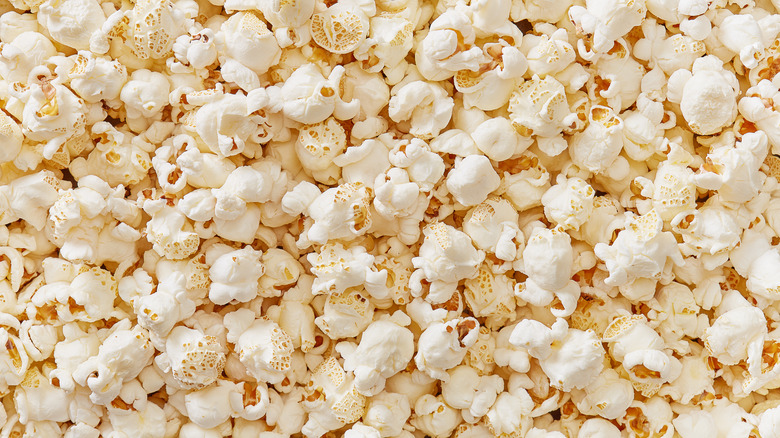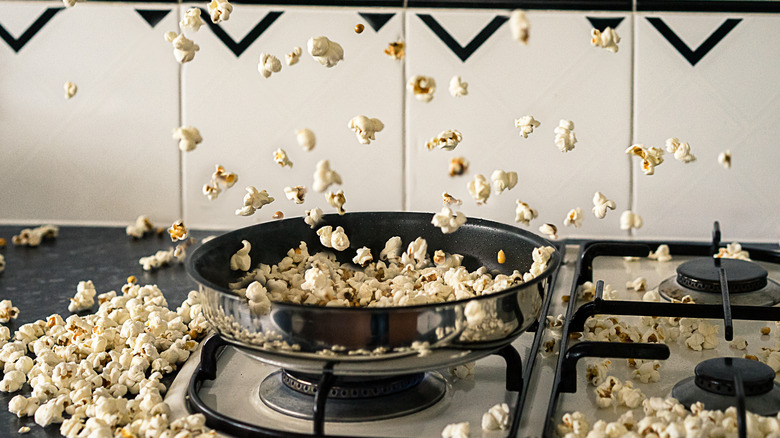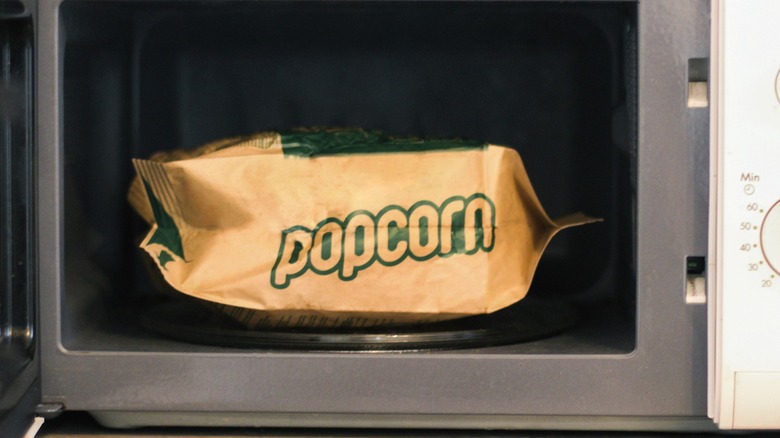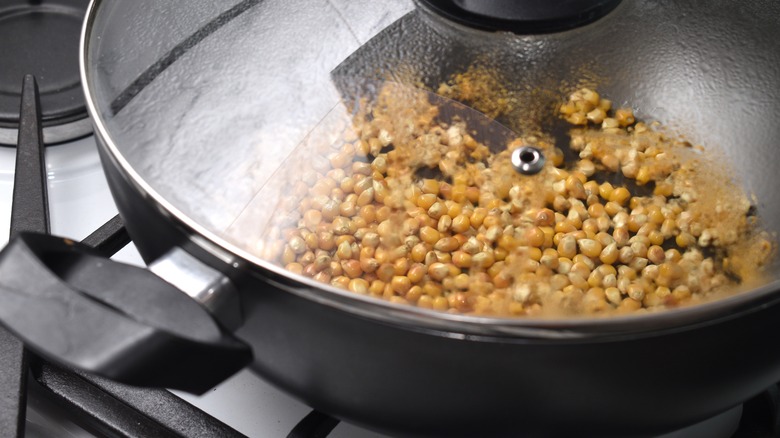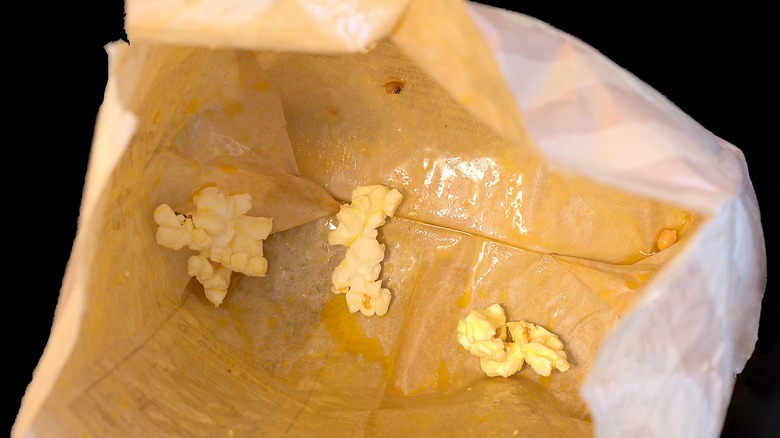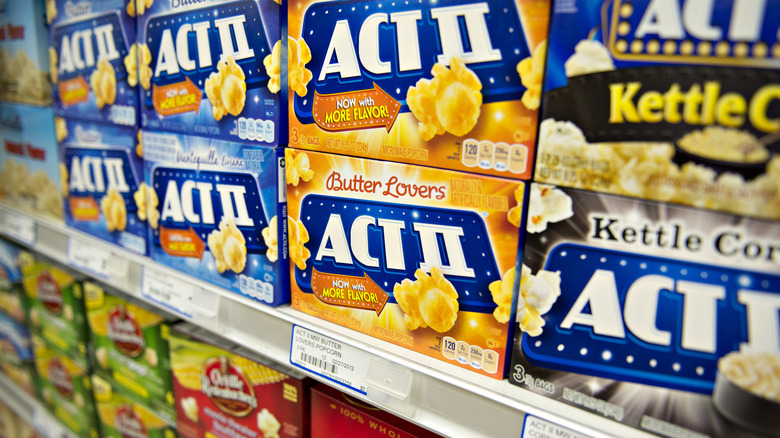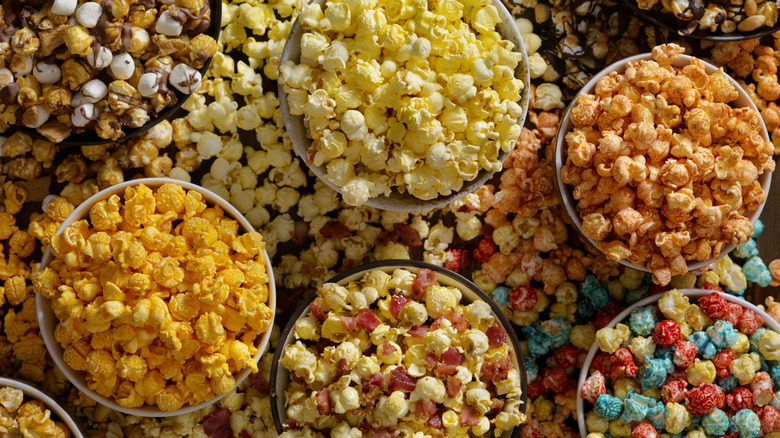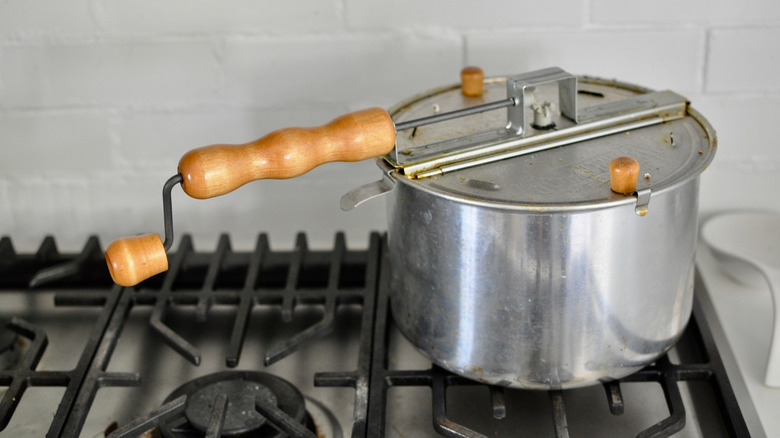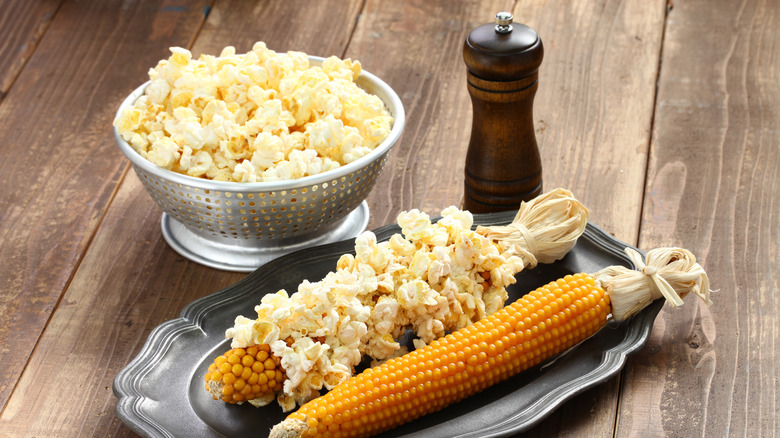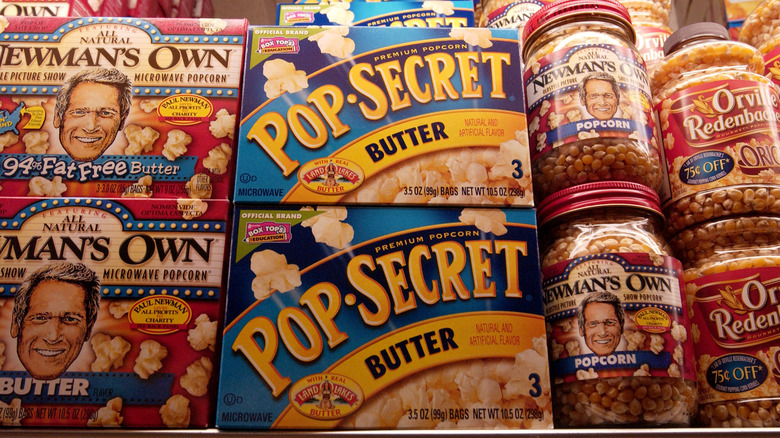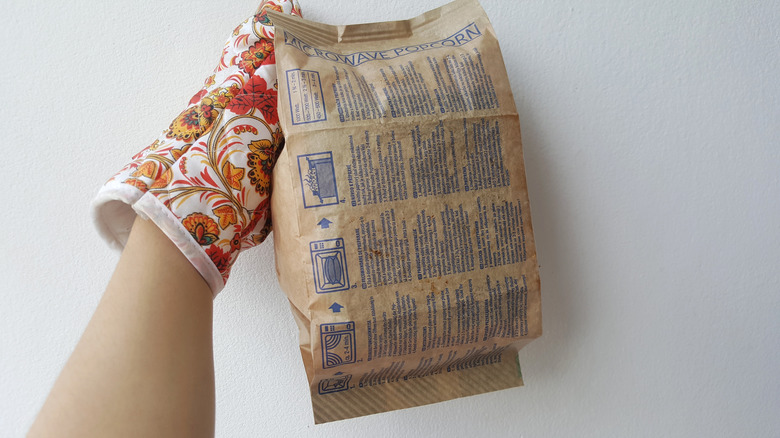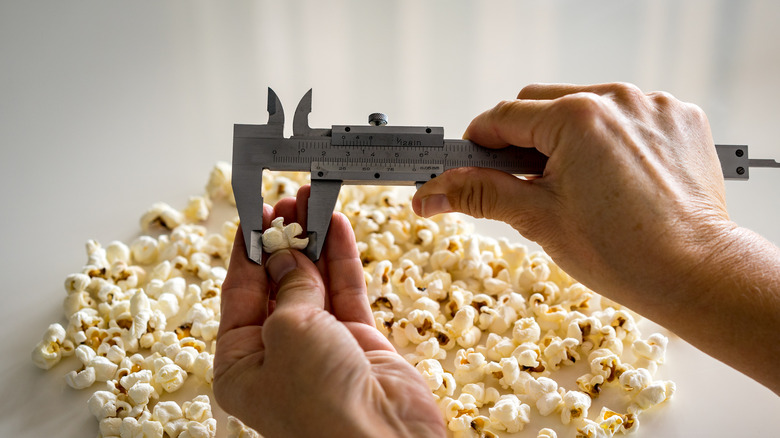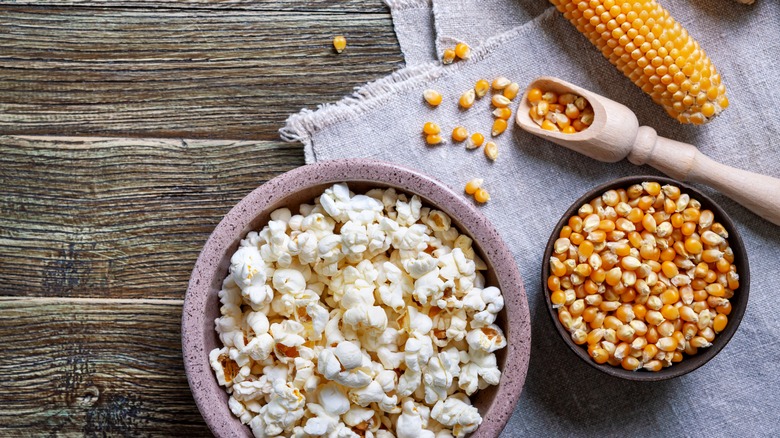Microwave Popcorn Vs Stovetop Popcorn: Everything You Need To Know
Everyone wants popcorn on movie night, but you haven't decided whether to get out your trusty pan or pop a bag of Act II in the microwave. This popcorn conundrum affects most U.S. households since people eat an average of 43 quarts per person per year, according to The Popcorn Board. The statisticians based that number on the amount of popcorn sold between 2016 and 2020. However you measure it, though, that's a lot of popcorn made from both the microwave and the stovetop.
Now, take a moment to consider what you most want from your bowl of popcorn before picking a package from the grocery store and deciding on the method of popping. A microwave bag will give you different characteristics and benefits than a batch of stovetop popcorn. Crispness, price, ease of popping, effort of clean-up, seasoning, and health are factors you might consider before making a final decision.
What is stovetop popcorn?
Any heat source — a campfire or hot air — can make popcorn expand into pillowy clouds of deliciousness. But when you use the appliance above the oven, you've got stovetop popcorn. Watching kernels in a pan is like witnessing magic. A single pearl-like seed of Zea mays everta, the only variety of corn that pops, expands up to 44 ½ according to Discovery UK. The moisture trapped inside becomes steam and transforms the starch around it. Then, the expanded innards burst out which causes the puffy, white ball to jump up and spin in the air.
Making popcorn on the stove may seem like the most traditional way to do it, but this method is relatively new. Just around 230 years ago, Count Rumford designed a wood-burning, cast iron stove with room for multiple pots and an easy way to regulate the temperature. In comparison, archeologists found the earliest specimens of popcorn in Bat Cave, New Mexico, and dated it back 4000 years according to The Popcorn Board. All that time, people had been making this snack over fires, hot coals, and even in clay jars with heated sand. Using a stove burner simplified the task of popping corn significantly. Precise control over the temperature and a reduced risk of burning hands and fingers turned popcorn into an easy, delicious snack.
What is microwave popcorn?
Popcorn played a part in the development of the microwave, so it's only fitting that the appliance is one of the most popular ways to prepare the snack today. Inventor Percy Spencer worked for Raytheon, a company dedicated to making radar equipment. One day, he noticed that a chocolate bar in his pocket had melted and thought this might have happened because of microwaves coming off some equipment. So, he decided to experiment with popcorn. He held a bag of kernels against the compact cavity magnetron, and sure enough, they popped. He used this knowledge to design the first microwave, applying for a patent in 1945, according to the Lemelson-MIT Program.
Spencer was ahead of his time by 36 years, and although he patented over 100 ideas (via Lemelson-MIT), he didn't think to add microwave popcorn to the list. Instead, General Mills had the honor in 1981, according to History. It was Pillsbury, though, that first distributed microwaveable bags of the stuff throughout the continental U.S. in 1982 as per The New York Times. Previously, microwave popcorn was a treat only available regionally. Since then, the popularity of the snack has grown tremendously — Statista calculated that U.S. sales of this product totaled more than $800 million in 2021. That's a lot of microwave popcorn.
Stovetop popcorn requires more time, skill, and clean up
Making stovetop popcorn requires precision. Do everything right, and it comes out delicious and crisp. You can simply wipe the pot out with a paper towel. Get distracted for a moment, though, you'll have a kitchen full of smoke and an impossible-to-scrub, charred-black pot. Preparing this snack demands your full, undivided attention for between five and 10 minutes.
The secret to making great popcorn is heating the oil to the perfect temperature. Use the kernel test to measure this — put your pot with a tablespoon of oil over the burner at medium-high heat and add two to four kernels. When they pop, remove the pot and pluck those popped kernels out with tongs — you don't want them burning later on. Now, cover the bottom of the pan with kernels, put on the lid, and let it set for 30 seconds so the temperature evens out. Return your pot to the burner with the lid ajar. Now the popping will start and you'll have the joy of hearing the tings of the jumping kernels colliding with the sides of the pot. When you detect just one little explosion about every two seconds, your snack is ready. If you managed to keep the popcorn from burning, the clean-up is easy. You'll only have to run your sponge over the pot, a serving bowl, and possibly a smaller container for melting butter or mixing up other popcorn toppings.
Microwave popcorn requires no clean-up
If it's your turn to host movie night, there are few snacks you could provide that are as hassle-free as microwave popcorn. There's no pot to scrub, you can serve it straight from the bag and the stuff comes pre-seasoned. Making this treat still requires your undivided attention once you press the start button, though. You'll need to nuke a bag of popcorn for between two and four minutes depending on the microwave, but that doesn't mean you can run to the bathroom, make a quick phone call, or answer the door. Just like using the stovetop, you should stay nearby and count the seconds between pops. When you hear one pop every two seconds, stop the microwave, but don't pull the bag out just yet. Let it sit in the microwave with the door shut for a few more minutes. The remaining heat may cause a few more kernels to pop, and you won't risk getting burned.
If you leave popcorn in the microwave too long, it can burn and leave a pungent odor. Then your snack will be ruined, and you'll find yourself googling how to get rid of the smell. By the way, big-brand appliance manufacturers recommend wiping out the interior and leaving a dish of baking soda inside overnight, if you ever find yourself in that particular pickle.
Microwave bags come preseasoned
The popcorn aisle at the grocery store has a huge offering of microwaveable popcorn flavors. Yes, there's the traditional movie theater-style, buttered popcorn, and also plain salted. A few companies have gotten more creative, though. For example, Orville Redenbacher's sells lime and salt popcorn under its Skinnygirl label. Then, ACT II offers hot and spicy. Jolly Time developed cheese-flavored popcorn. Several brands also produce sweet and salty kettle corn.
There is a clear benefit to purchasing pre-seasoned, microwaveable popcorn — you don't have to worry about what to put on it. Many snackers just want something delicious to eat without having to think too much. Considering salt and butter vs. sriracha and smoked paprika, and then dirtying some dishes in the kitchen winds up being too much of an effort some days. In that sense, microwave popcorn has got your back.
On the other hand, letting food manufacturers season your popcorn means you can't closely control how much sodium or fat is in the snack. Anyone on a low-sodium diet, for example, would be much better off adding seasoning at home. That's an option too, because companies like Black Jewell sell microwaveable popcorn with no seasoning or oil with just 5 mg of sodium.
You can get creative when seasoning stovetop popcorn
When you make stovetop popcorn, the possibilities are endless. These puffy white flakes are blank canvases and you can paint them however you like. For example, try making caramel apple popcorn. This recipe asks cooks to pour homemade maple caramel over popcorn, and then sprinkle dried apples on top. It's ready to eat after 20 minutes in the oven to harden the coating. Alternatively, you might like peanut butter popcorn. Melt a mix of honey and peanut butter on the stove and pour it over the fluffy white puffs. Top it off with some peanuts for crunch. It's incredibly tasty, but it will make your hands gooey.
The best toppings for popcorn are spices or mixes that will stick to the flakes without making them soggy. That means thicker sauces (like peanut butter or caramel) give better results than thinner ones. Sometimes mixing powders, for example, cayenne and garlic, with butter helps coat the snack more evenly. Putting popcorn in a bag, then adding seasoning, and shaking also contributes to uniform coverage.
Stovetop and microwave require different equipment
Depending on where you're making popcorn, the microwave or stovetop, you'll need to get different supplies ready or perhaps none at all. Pre-packaged, microwave popcorn is the simplest. It requires only the common kitchen appliance in its name and is so simple you can make it in a hotel room or even an office.
There is another type of microwave popcorn, though, and you don't need a pre-packaged baggy to make it — use loose kernels in a microwave popper. This kitchenware is usually glass or silicone and costs between $9 and $20 via Amazon. Most people get great results with these. Others, though, complain that the silicon heats up too much and that many kernels don't pop.
Making stovetop popcorn means using a specific type of pan — one that's light and has a lid. You may need to experiment with several pots before finding one that works well. Using a crank-stirring popper requires far less trial and error, but they take up precious shelf space, and can be more expensive than other options. This item usually costs around $40. It's worth it, though, if you like crisp popcorn since The New York Times Wirecutter says this method of making popcorn produces the best texture.
You can grow stovetop popcorn in your garden
Imagine planting kernels in your garden in the spring, caring for stalks all summer, and harvesting ears in the fall. Putting those kernels into your popper might feel more satisfying than buying a jar of Orville Redenbacher's, even though it's a lot more work. You'd forge a different connection with your favorite movie night snack.
Not everyone has the space and time to grow popcorn, though. If you live in a rented apartment, growing popcorn isn't realistic because it won't grow in planters. Gardeners usually plant at least four rows so corn can pollinate, and this crop requires 18 inches between each row. That means you need an area of at least two yards by two yards. This crop usually takes between 90 to 120 days from sowing until harvest. In other words, if you live in a region with a short summer, popcorn may not be for you either.
Your taste buds will thank you if you plant popcorn. For example, you might discover new, more complex tastes. In an interview with the New York Times, soil expert and popcorn grower Gene Mealhow explains how he loves the taste of heirloom popcorn. He says it's akin to a mix between sweet corn and toast. Orville Redenbacher's product, in his opinion, may pop big and beautiful, but tastes like nothing. If growing your own popcorn seems overwhelming, you could always buy Mealhow's heirloom brand of popcorn, Tiny but Mighty.
Microwave popcorn is more expensive
Pre-packaged microwave popcorn is more expensive than buying kernels in a jar or bag. You can buy 32 ounces of Jolly Time for about $2.30. That's just $.07 per ounce. Microwaveable popcorn costs significantly more. A six-pack of 3.2-ounce bags from the same company goes for around $3.90 or $.20 per ounce. That's nearly three times as expensive.
Companies have started marketing popcorn as a healthy food because it is a whole, unprocessed cereal low in sugar and fat, but this has led to differences in price as well. Interestingly, brands that promote their product as healthy, tend to charge a higher price, particularly for products directed toward women on diets. Orville Redenbacher sells a 12-pack of traditional movie theater microwave popcorn for about $6.40, $.16 per ounce. The same company also sells Skinnygirl Popcorn. This comes in a 10-mini-bag box and costs $4.80, but the price per ounce is nearly $.32. That doubled price could be attributed to the number of microwaveable bags needed even though there are fewer ounces inside each one, or it could be that marketing experts know this demographic is willing to spend more. Even so, people on diets will get a much better deal and be able to follow their diets more closely by buying stovetop popcorn. Then, they can control the amount they prepare only adding as much salt and butter as they want.
Commercial microwave popcorn packaging may contain PFAS
Some of the bags used to package microwave popcorn contain PFAS. This is a chemical that makes paper more resistant to grease. Fast food restaurant packaging like pizza boxes and hamburger wrappers often contain it as well. Researchers have linked this substance to low fertility, high blood pressure, and cancer. There are different kinds of PFAS, and some are more harmful than others. The FDA has been carefully analyzing the use of this chemical, but still allows it in microwaveable popcorn wrappers. A study published in 2019 in Environmental Health Perspectives found that people who regularly ate microwave popcorn had higher levels of PFAS in their blood.
This means that regularly eating microwave popcorn could pose a health risk, but you may not want to worry just yet. First, you would have to eat it very often for this snack to have a negative impact. Next, the industry is actively working on improving packaging. They are looking at reducing the number of PFAS and changing the more dangerous kind to a safer type. There are even a few brands that have managed to remove PFAS, so you might want to carefully read the packaging before buying. For example, Black Jewell Popcorn says its microwave bags are PFAS and PFOA-free. The easiest way to avoid these chemicals, though, is to buy popcorn to make on the stovetop.
Final verdict
The best type of popcorn for you depends on what you value. If it's taste and texture, making it on the stovetop in a crank-stirrer is the best. Keep in mind you have to eat this snack frequently to make purchasing and storing the single-tasked kitchen gadget worthwhile. Budget shoppers will also prefer buying kernels to make over a burner, although they might like making it in a pot as opposed to a popper. Snackers looking for the most natural option and worried about sodium or PFAS should also turn to their stovetops.
On the other hand, people who prefer efficiency and convenience, but are not worried about cost, should buy pre-packaged microwave popcorn. Hosts preparing fast, easy, abundant snacks are the champions of this product. The health issues related to eating microwave popcorn will likely have little to no impact on consumers unless they make this snack nearly every day.
Methodology
Writing about popcorn felt easy because it has always been a favorite snack. My family loves it because everyone at home can eat it, even my partner who's on a gluten-free diet. It's easy to make in a few minutes and even better, my kids adore it. So, we often pop up a batch for sharing before visiting friends — we never know if offerings elsewhere will contain wheat or not. Additionally, we source most of our popcorn from my uncle's farm in South Dakota. Every year he gives us so much of the stuff we can't finish it.
So, I have practice with making popcorn. I used to rely on a huge, but light aluminum pot, perfect for shaking. During the pandemic, I invested in a popper with a crank and stirring stick. It ranks in the top 10 of my best household purchases ever. I usually steer clear of microwave popcorn, though, and you'll notice my personal bias throughout this article.
To gather information, I used my personal experience described above but backed it up with information from outside sources. I turned to publications like the New York Times, The Popcorn Board, and America's Test Kitchen where the cooks coincidentally recommended the exact procedure for making popcorn I used to follow with my aluminum pot. I considered characteristics like taste, texture, health, price, and ease when making recommendations. Finally, the information I gathered about PFAS comes from the UCLA Center for Human Nutrition.
